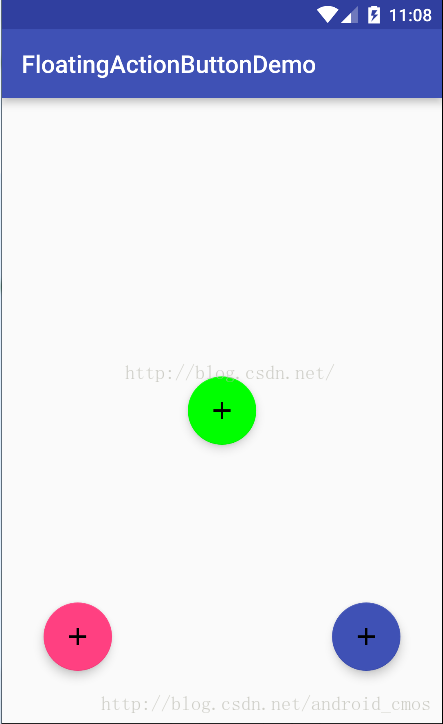这篇文章主要介绍Android如何实现自定义可拖拽的悬浮按钮DragFloatingActionButton,文中介绍的非常详细,具有一定的参考价值,感兴趣的小伙伴们一定要看完!
悬浮按钮FloatingActionButton是Android 5.0系统添加的新控件,FloatingActionButton是继承至ImageView,所以FloatingActionButton拥有ImageView的所有属性。本文讲解的是一个实现了可拖拽的悬浮按钮,并为此添加了类似于qq的吸附边框的功能。在此之前,先了解下其简单的使用方式吧:
首先你得添加其依赖
compile 'com.android.support:design:25.3.1'然后在布局文件中使用。
<android.support.design.widget.FloatingActionButton
android:layout_width="wrap_content"
android:layout_height="wrap_content"
android:layout_gravity="right|bottom"
android:src="@drawable/ic_launcher"
/>如图:

FloatingActionButton正常显示的情况下有个填充的颜色,有个阴影;点击的时候会有一个rippleColor,并且阴影的范围可以增大。其中:
1、填充的颜色默认使用就是style当中的colorAccent。
2、rippleColor默认取的是Theme当中的colorControlHighlight。
3、elevation和pressedTranslationZ,前者用户设置正常显示的阴影大小;后者是点击时显示的阴影大小。
好了,现在介绍本文的重点:可拖拽的,有吸附功能的悬浮按钮
先上代码。
import android.animation.ObjectAnimator;
import android.content.Context;
import android.support.design.widget.FloatingActionButton;
import android.util.AttributeSet;
import android.util.Log;
import android.view.MotionEvent;
import android.view.animation.DecelerateInterpolator;
public class DragFloatActionButton extends FloatingActionButton {
private int screenWidth;
private int screenHeight;
private int screenWidthHalf;
private int statusHeight;
private int virtualHeight;
public DragFloatActionButton(Context context) {
super(context);
init();
}
public DragFloatActionButton(Context context, AttributeSet attrs) {
super(context, attrs);
init();
}
public DragFloatActionButton(Context context, AttributeSet attrs, int defStyleAttr) {
super(context, attrs, defStyleAttr);
init();
}
private void init() {
screenWidth = ScreenUtils.getScreenWidth(getContext());
screenWidthHalf = screenWidth / 2;
screenHeight = ScreenUtils.getScreenHeight(getContext());
statusHeight = ScreenUtils.getStatusHeight(getContext());
virtualHeight=ScreenUtils.getVirtualBarHeigh(getContext());
}
private int lastX;
private int lastY;
private boolean isDrag;
@Override
public boolean onTouchEvent(MotionEvent event) {
int rawX = (int) event.getRawX();
int rawY = (int) event.getRawY();
switch (event.getAction() & MotionEvent.ACTION_MASK) {
case MotionEvent.ACTION_DOWN:
isDrag = false;
getParent().requestDisallowInterceptTouchEvent(true);
lastX = rawX;
lastY = rawY;
Log.e("down---->", "getX=" + getX() + ";screenWidthHalf=" + screenWidthHalf);
break;
case MotionEvent.ACTION_MOVE:
isDrag = true;
//计算手指移动了多少
int dx = rawX - lastX;
int dy = rawY - lastY;
//这里修复一些手机无法触发点击事件的问题
int distance= (int) Math.sqrt(dx*dx+dy*dy);
Log.e("distance---->",distance+"");
if(distance<3){//给个容错范围,不然有部分手机还是无法点击
isDrag=false;
break;
}
float x = getX() + dx;
float y = getY() + dy;
//检测是否到达边缘 左上右下
x = x < 0 ? 0 : x > screenWidth - getWidth() ? screenWidth - getWidth() : x;
// y = y < statusHeight ? statusHeight : (y + getHeight() >= screenHeight ? screenHeight - getHeight() : y);
if (y<0){
y=0;
}
if (y>screenHeight-statusHeight-getHeight()){
y=screenHeight-statusHeight-getHeight();
}
setX(x);
setY(y);
lastX = rawX;
lastY = rawY;
Log.e("move---->", "getX=" + getX() + ";screenWidthHalf=" + screenWidthHalf + " " + isDrag+" statusHeight="+statusHeight+ " virtualHeight"+virtualHeight+ " screenHeight"+ screenHeight+" getHeight="+getHeight()+" y"+y);
break;
case MotionEvent.ACTION_UP:
if (isDrag) {
//恢复按压效果
setPressed(false);
Log.e("ACTION_UP---->", "getX=" + getX() + ";screenWidthHalf=" + screenWidthHalf);
if (rawX >= screenWidthHalf) {
animate().setInterpolator(new DecelerateInterpolator())
.setDuration(500)
.xBy(screenWidth - getWidth() - getX())
.start();
} else {
ObjectAnimator oa = ObjectAnimator.ofFloat(this, "x", getX(), 0);
oa.setInterpolator(new DecelerateInterpolator());
oa.setDuration(500);
oa.start();
}
}
Log.e("up---->",isDrag+"");
break;
}
//如果是拖拽则消耗事件,否则正常传递即可。
return isDrag || super.onTouchEvent(event);
}
}ScreenUtils.Java
package com.example.cmos.retrofitdemo;
import android.app.Activity;
import android.content.Context;
import android.graphics.Rect;
import android.util.DisplayMetrics;
import android.view.Display;
import android.view.Window;
import android.view.WindowManager;
import java.lang.reflect.Method;
/**
* Created by gongwq on 2017/6/14 0014.
*/
public class ScreenUtils {
private ScreenUtils() {
/* cannot be instantiated */
throw new UnsupportedOperationException("cannot be instantiated");
}
/**
* 获得屏幕高度
*
* @param context
* @return
*/
public static int getScreenWidth(Context context) {
WindowManager wm = (WindowManager) context
.getSystemService(Context.WINDOW_SERVICE);
DisplayMetrics outMetrics = new DisplayMetrics();
wm.getDefaultDisplay().getMetrics(outMetrics);
return outMetrics.widthPixels;
}
/**
* 获得屏幕宽度
*
* @param context
* @return
*/
public static int getScreenHeight(Context context) {
WindowManager wm = (WindowManager) context
.getSystemService(Context.WINDOW_SERVICE);
DisplayMetrics outMetrics = new DisplayMetrics();
wm.getDefaultDisplay().getMetrics(outMetrics);
return outMetrics.heightPixels;
}
/**
* 获得状态栏的高度
*
* @param context
* @return
*/
public static int getStatusHeight(Context context) {
int statusHeight = -1;
try {
Class<?> clazz = Class.forName("com.android.internal.R$dimen");
Object object = clazz.newInstance();
int height = Integer.parseInt(clazz.getField("status_bar_height")
.get(object).toString());
statusHeight = context.getResources().getDimensionPixelSize(height);
} catch (Exception e) {
e.printStackTrace();
}
return statusHeight;
}
/**
* 获取虚拟功能键高度
*/
public static int getVirtualBarHeigh(Context context) {
int vh = 0;
WindowManager windowManager = (WindowManager) context.getSystemService(Context.WINDOW_SERVICE);
Display display = windowManager.getDefaultDisplay();
DisplayMetrics dm = new DisplayMetrics();
try {
@SuppressWarnings("rawtypes")
Class c = Class.forName("android.view.Display");
@SuppressWarnings("unchecked")
Method method = c.getMethod("getRealMetrics", DisplayMetrics.class);
method.invoke(display, dm);
vh = dm.heightPixels - windowManager.getDefaultDisplay().getHeight();
} catch (Exception e) {
e.printStackTrace();
}
return vh;
}
public static int getVirtualBarHeigh(Activity activity) {
int titleHeight = 0;
Rect frame = new Rect();
activity.getWindow().getDecorView().getWindowVisibleDisplayFrame(frame);
int statusHeight = frame.top;
titleHeight = activity.getWindow().findViewById(Window.ID_ANDROID_CONTENT).getTop() - statusHeight;
return titleHeight;
}
}上面的代码也很简单,相信看代码中的注释就可以看的明白了。但是这里还是讲下其实现原理:这个自定义的悬浮按钮,我们主要是重写了其onTouch事件,捕捉触摸事件,然后利用setX(),setY()方法将其移动。而吸附效果,主要是利用的属性动画,最后,不要忘了return 是否还在拖拽的结果,免得无法触发点击事件。
PS
最后贴一个弹出框。推荐用popmenu,相比于popwindow,这个会自动调整显示的位置,这在拖拽的悬浮按钮中很有用,因为如果用后者,你将按钮移到屏幕上方,而当你的弹出框也是设置在显示的悬浮按钮的上方,那么就有可能会遮挡弹出框的内容。
dragFloatActionButton= (DragFloatActionButton) findViewById(R.id.floatBtn);
dragFloatActionButton.setOnClickListener(this);
....
@Override
public void onClick(View view) {
switch (view.getId()) {
case R.id.floatBtn:
PopupMenu popupMenu=new PopupMenu(this,view);
getMenuInflater().inflate(R.menu.pop_item,popupMenu.getMenu());
popupMenu.setOnMenuItemClickListener(new PopupMenu.OnMenuItemClickListener() {
@Override
public boolean onMenuItemClick(MenuItem menuItem) {
switch (menuItem.getItemId()){
case R.id.action_last:
Toast.makeText(TestActivity.this,""+menuItem.getItemId(),Toast.LENGTH_SHORT).show();
break;
case R.id.action_next:
Toast.makeText(TestActivity.this,""+menuItem.getItemId(),Toast.LENGTH_SHORT).show();
break;
}
return false;
}
});
popupMenu.show();
Log.e("****--->","float");
// Toast.makeText(this,"flaot---",Toast.LENGTH_SHORT).show();
break;
}
}新建menu文件夹,在里面添加pop_item.xml文件
<?xml version="1.0" encoding="utf-8"?>
<menu xmlns:android="http://schemas.android.com/apk/res/android"
xmlns:app="http://schemas.android.com/apk/res-auto">
<item
android:id="@+id/action_delete"
android:orderInCategory="100"
android:title="删除"
app:showAsAction="never" />
<item
android:id="@+id/action_save"
android:orderInCategory="200"
android:title="保存"
app:showAsAction="never" />
<item
android:id="@+id/action_last"
android:orderInCategory="300"
android:title="上一步"
app:showAsAction="never" />
<item
android:id="@+id/action_next"
android:icon="@null"
android:orderInCategory="400"
android:title="下一步"
app:showAsAction="never" />
</menu>以上是“Android如何实现自定义可拖拽的悬浮按钮DragFloatingActionButton”这篇文章的所有内容,感谢各位的阅读!希望分享的内容对大家有帮助,更多相关知识,欢迎关注亿速云行业资讯频道!
亿速云「云服务器」,即开即用、新一代英特尔至强铂金CPU、三副本存储NVMe SSD云盘,价格低至29元/月。点击查看>>
免责声明:本站发布的内容(图片、视频和文字)以原创、转载和分享为主,文章观点不代表本网站立场,如果涉及侵权请联系站长邮箱:is@yisu.com进行举报,并提供相关证据,一经查实,将立刻删除涉嫌侵权内容。